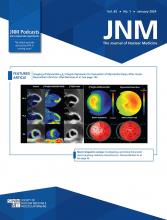Visual Abstract
Abstract
The overexpression of fibroblast activation protein-α (FAP) in solid cancers relative to levels in normal tissues has led to its recognition as a target for delivering agents directly to tumors. Radiolabeled quinoline-based FAP ligands have established clinical feasibility for tumor imaging, but their therapeutic potential is limited due to suboptimal tumor retention, which has prompted the search for alternative pharmacophores. One such pharmacophore is the boronic acid derivative N-(pyridine-4-carbonyl)-d-Ala-boroPro, a potent and selective FAP inhibitor (FAPI). In this study, the diagnostic and therapeutic (theranostic) potential of N-(pyridine-4-carbonyl)-d-Ala-boroPro–based metal-chelating DOTA-FAPIs was evaluated. Methods: Three DOTA-FAPIs, PNT6555, PNT6952, and PNT6522, were synthesized and characterized with respect to potency and selectivity toward soluble and cell membrane FAP; cellular uptake of the Lu-chelated analogs; biodistribution and pharmacokinetics in mice xenografted with human embryonic kidney cell–derived tumors expressing mouse FAP; the diagnostic potential of 68Ga-chelated DOTA-FAPIs by direct organ assay and small-animal PET; the antitumor activity of 177Lu-, 225Ac-, or 161Tb-chelated analogs using human embryonic kidney cell–derived tumors expressing mouse FAP; and the tumor-selective delivery of 177Lu-chelated DOTA-FAPIs via direct organ assay and SPECT. Results: DOTA-FAPIs and their natGa and natLu chelates exhibited potent inhibition of human and mouse sources of FAP and greatly reduced activity toward closely related prolyl endopeptidase and dipeptidyl peptidase 4. 68Ga-PNT6555 and 68Ga-PNT6952 showed rapid renal clearance and continuous accumulation in tumors, resulting in tumor-selective exposure at 60 min after administration. 177Lu-PNT6555 was distinguished from 177Lu-PNT6952 and 177Lu-PNT6522 by significantly higher tumor accumulation over 168 h. In therapeutic studies, all 3 177Lu-DOTA-FAPIs exhibited significant antitumor activity at well-tolerated doses, with 177Lu-PNT6555 producing the greatest tumor growth delay and animal survival. 225Ac-PNT6555 and 161Tb-PNT6555 were similarly efficacious, producing 80% and 100% survival at optimal doses, respectively. Conclusion: PNT6555 has potential for clinical translation as a theranostic agent in FAP-positive cancer.
Footnotes
Published online Nov. 30, 2023.
- © 2024 by the Society of Nuclear Medicine and Molecular Imaging.








